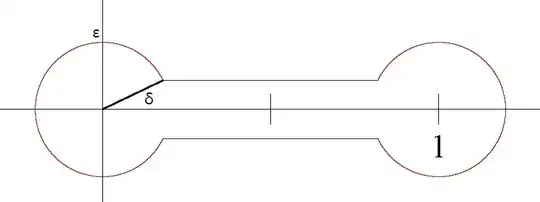I will write an outline of the proof that the integral in OP is $2$. If some intensive calculation is needed, I will put (*k) with increasing numbers k, but not include the calculation.
The same method as in this is applied. We define the function $f(z)$ same as above. To recall, it is
$$
f(z)=\exp(i\pi z + z \log z + (1-z)\log(1-z)),$$
where $-\pi\leq \arg z < \pi$ and $0\leq \arg(1-z) < 2\pi$.
But, in this problem, we need $g(z)$ where
$$
g(z) = f(z)^{-1}.
$$
We now consider the integral of $g(z)/(z(1-z))$ along the following contour:
Fix a small $\delta>0$ and a small $\epsilon>0$.
Draw two circles with radius $\epsilon$ centered at $0$ and $1$ respectively. We will call the circle centered at $0$ as $L_{\epsilon}$, centered at $1$ as $R_{\epsilon}$.
Erase a part of $L_{\epsilon}$ consisting of a smaller arc between $\epsilon e^{-i\delta}$ and $\epsilon e^{i\delta}$, and erase a part of $R_{\epsilon}$ consisting of a smaller arc between $1-\epsilon e^{i\delta}$ and $1-\epsilon e^{-i\delta}$. We will call the remaining arcs $L_{\delta, \epsilon}$ and $R_{\delta, \epsilon}$ respectively.
Connect the points $\epsilon e^{i\delta}$ and $1-\epsilon e^{-i\delta}$ by a straight line segment $U_{\delta,\epsilon}$, and connect the points $\epsilon e^{-i\delta}$ and $1-\epsilon e^{i\delta}$ by a straight line segment $D_{\delta,\epsilon}$.
We call this closed contour as $\Omega_{\delta,\epsilon}$.
The contour looks like this:
 Then by Cauchy residue theorem, we have
$$
\int_{\Omega_{\delta,\epsilon}} \frac{g(z)}{z(1-z)} dz = -\mathrm{Res}_{z=\infty} \frac{g(z)}{z(1-z)} = 0. \ \textrm{ (*1) }
$$
Then by Cauchy residue theorem, we have
$$
\int_{\Omega_{\delta,\epsilon}} \frac{g(z)}{z(1-z)} dz = -\mathrm{Res}_{z=\infty} \frac{g(z)}{z(1-z)} = 0. \ \textrm{ (*1) }
$$
Then we need to estimate $g(z)/(z(1-z))$ on the contour $\Omega_{\delta,\epsilon}$. We start with $U_{\delta,\epsilon}$.
If $z\in U_{\delta,\epsilon}$, then $\overline{z}\in D_{\delta,\epsilon}$. Thus,
$$
\int_{D_{\delta,\epsilon}} + \int_{-U_{\delta,\epsilon}} = 2i\Im \int_{D_{\delta,\epsilon}}=e^{O(\delta)} \int_{\epsilon\cos \delta}^{1-\epsilon\cos\delta} 2i\sin (-\pi r+O(\delta|\log\epsilon|)) \frac1{r^{r+1}(1-r)^{2-r}} dr . \ \textrm{(*2)}$$
For $z\in L_{\delta,\epsilon}$, we have
$$
g(z)=\exp(O(\epsilon |\log \epsilon |)). \ \textrm{(*3)}
$$
Also for $z\in R_{\delta,\epsilon}$, we have
$$
g(z)=\exp(O(\epsilon |\log\epsilon|)). \ \textrm{(*4)}$$
Thus, for integrals, we have
$$
\int_{L_{\delta,\epsilon}} = (2\pi - 2\delta)i \exp(O(\epsilon |\log\epsilon|)),
$$
and
$$
\int_{R_{\delta,\epsilon}} = (2\pi - 2\delta)i \exp(O(\epsilon |\log\epsilon|)),
$$
Letting $\delta\rightarrow 0+$, we obtain that
$$
-2i \int_{\epsilon}^{1-\epsilon} (\sin \pi r) \frac1{r^{r+1}(1-r)^{2-r}} dr + 2 (2\pi )i \exp(O(\epsilon|\log\epsilon|))=0.
$$
Letting $\epsilon\rightarrow 0+$, we obtain that
$$
-2i \int_0^1 (\sin \pi r)\frac1{r^{r+1}(1-r)^{2-r}} dr + 2 \cdot 2\pi i =0.
$$
Therefore, we have the desired result
$$
\int_0^1 (\sin \pi r) \frac1{r^{r+1}(1-r)^{2-r}} dr = 2\pi.
$$
